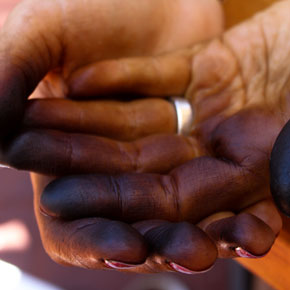Here in Dothan, Alabama, we find ourselves not only in the Bible Belt but also in pecan country. Often pronounced “pee-cans”, these soft-shelled nuts play the starring roles in candies, pies, casseroles and more. But in no less than 32 states, a nut of a whole different nature plays the lead and that nut is the black walnut. The black walnut tree is the most fully utilized tree in America. The tasty nut meat is a popular treat; the wood is used in many applications including furniture and gun stocks; the husks are utilized in making dyes; the shells– the toughest of any tree nut in the world– is used in a variety of industrial applications (including abrasive cleaning, water filtration and oil industry). The black walnut tree is fully utilized much as the American Indian utilized every part of an animal– waste not, want not.
Harvesting black walnuts range anything from a hand collecting operation to nut rollers to pull-behind picker uppers and up. The process can be messy as black walnuts secret juglone– a toxic substance (primarily to plants) that is hard to remove from hands, clothes and more. The harvesting process is much easier with a tool designed to make the collection hands-off. Our favorites listed in order of price: Holt’s Nut Wizard, Stab-A-Nut Black Walnut Harvester and Bag-A-Nut Black Walnut Harvester.
Will not wash off– but will fade in 1-2 weeks time.

After the collection process, two tasks are at hand: removing the husk and cracking the shell. The husk is the outer-casing on the black walnut. Make life easier and wait until this husk turns from green to black. This also ensures that the walnut is dried out– which is the perfect state for cracking. To remove the husks, you can do this manually– which gets messy. Or you can employ a wide variety of tactics. My favorites include– running over them with a car (likely not very effective for large quantities), placing them in a cement mixer with sand (very effective) and placing them in a wire cage and pressure washing them. In areas of the country where black walnuts are prolific, there are processors that remove the husks. Drop me a line if you determine a faster or easier way.

Removing the husks of black walnuts requires creativity but cracking them is a whole different task. Again, we’ve heard of lots of creative ways to do this but please heed this advice. Find a good black walnut cracker– and buy it. A good cracker will last for many years and make this difficult task simple. The shell of a black walnut is so hard that they are used for industrial applications! That alone shows you how hard the shell is. In the past, people have used methods including hammers. Really, don’t. This is asking for troubles! We recommend the following crackers in order of price: Steel Nutcracker II, Kenkel, Master Cracker and Drill Cracker. Guess what? All of them are quality-built, American-made crackers.
Thanks for following us through the journey of a black walnut primer. Comment or jot us a line about your black walnut questions or advice. We’d love to hear from you.















